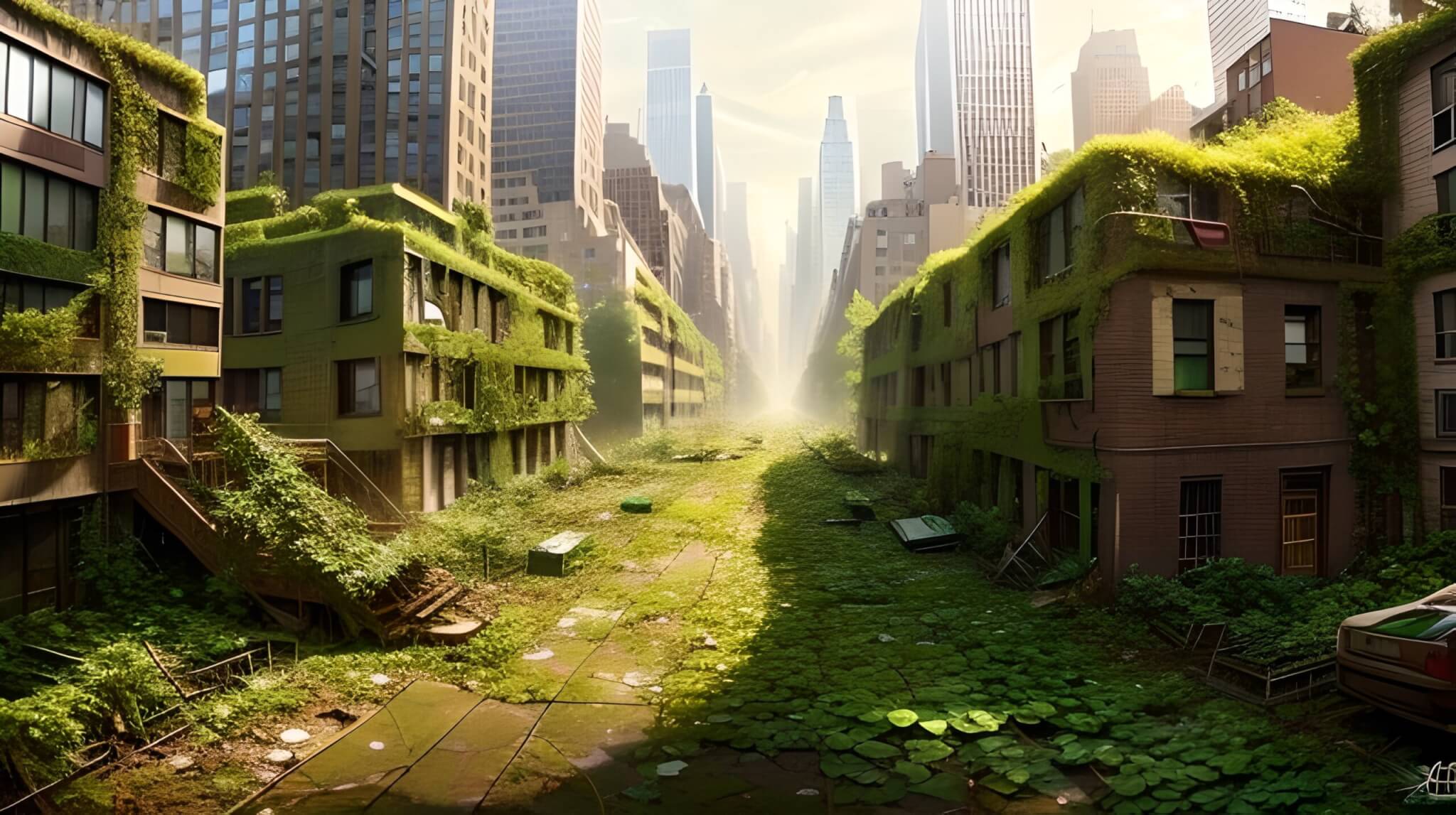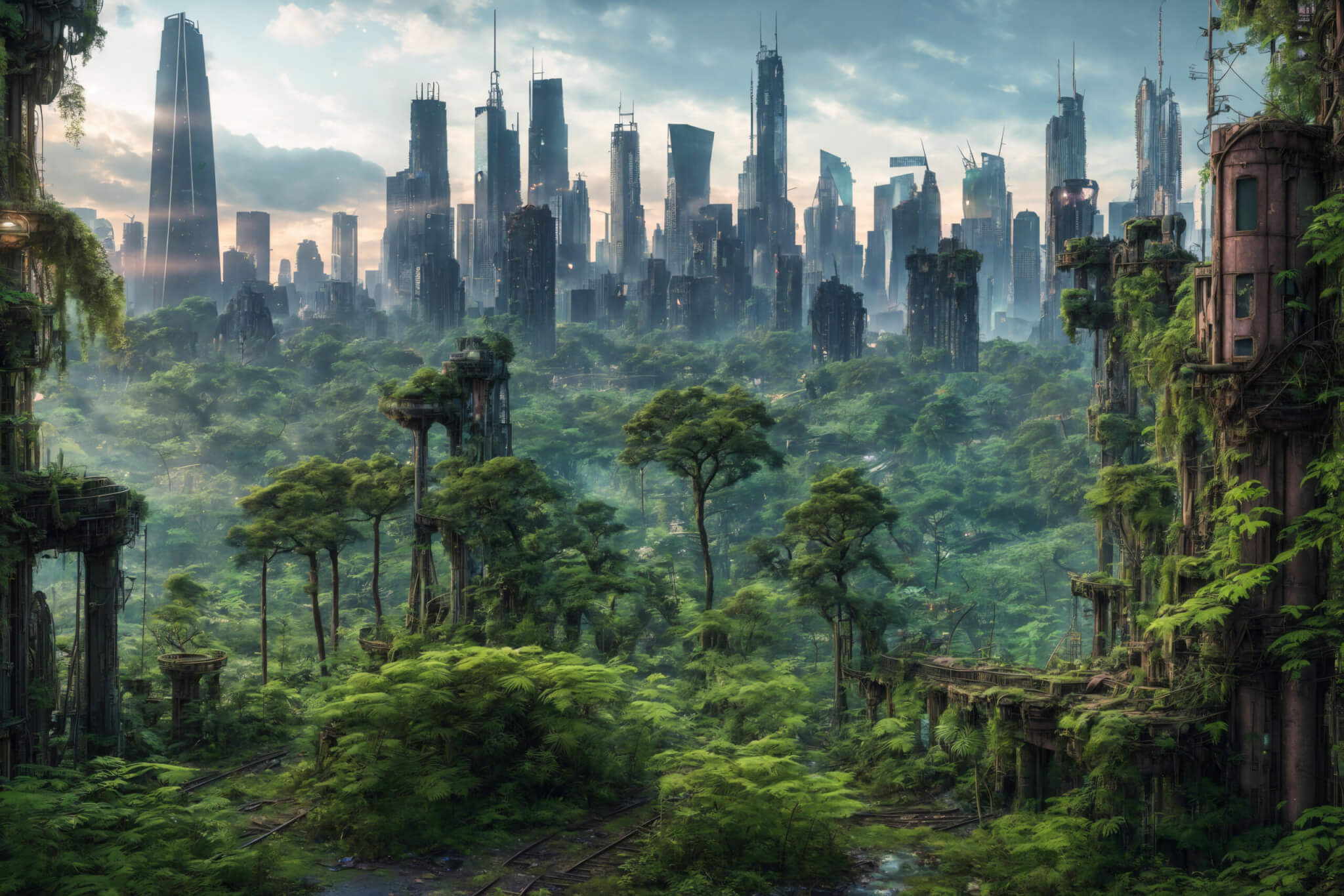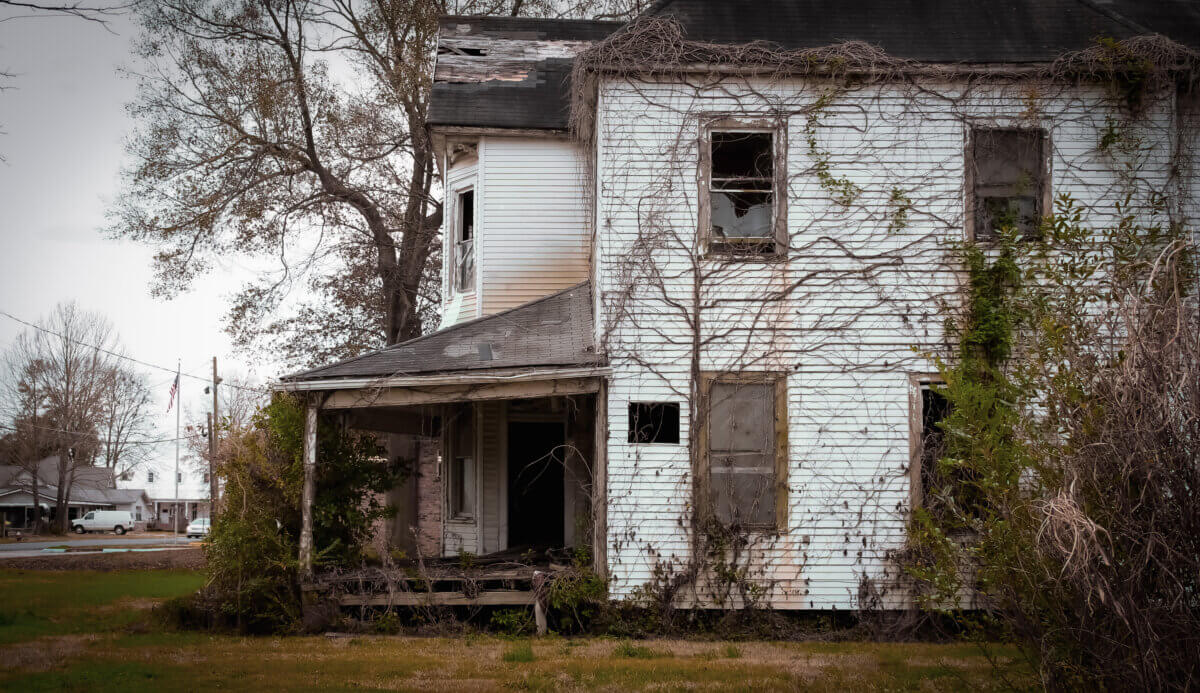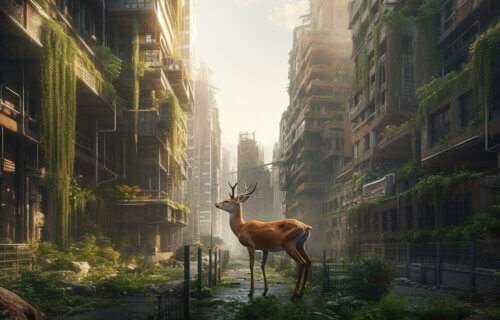Have you ever wondered what the world would be like if everyone suddenly disappeared?
What would happen to all our stuff? What would happen to our houses, our schools, our neighborhoods, our cities? Who would feed the dog? Who would cut the grass? Although it’s a common theme in movies, TV shows and books, the end of humanity is still a strange thing to think about.
But as an associate professor of urban design – that is, someone who helps towns and cities plan what their communities will look like – it’s sometimes my job to think about prospects like this.
So much silence
If humans just disappeared from the world, and you could come back to Earth to see what had happened one year later, the first thing you’d notice wouldn’t be with your eyes.
It would be with your ears.

The world would be quiet. And you would realize how much noise people make. Our buildings are noisy. Our cars are noisy. Our sky is noisy. All of that noise would stop.
You’d notice the weather. After a year without people, the sky would be bluer, the air clearer. The wind and the rain would scrub clean the surface of the Earth; all the smog and dust that humans make would be gone.
Home sweet home
Imagine that first year, when your house would sit unbothered by anyone.
Go inside your house – and hope you’re not thirsty, because no water would be in your faucets. Water systems require constant pumping. If no one’s at the public water supply to manage the machines that pump water, then there’s no water.
But the water that was in the pipes when everyone disappeared would still be there when the first winter came – so on the first cold snap, the frigid air would freeze the water in the pipes and burst them.
There would be no electricity. Power plants would stop working because no one would monitor them and maintain a supply of fuel. So your house would be dark, with no lights, TV, phones or computers.

Your house would be dusty. Actually, there’s dust in the air all the time, but we don’t notice it because our air conditioning systems and heaters blow air around. And as you move through the rooms in your house, you keep dust on the move too. But once all that stops, the air inside your house would be still and the dust would settle all over.
The grass in your yard would grow – and grow and grow until it got so long and floppy it would stop growing. New weeds would appear, and they would be everywhere.
Lots of plants that you’ve never seen before would take root in your yard. Every time a tree drops a seed, a little sapling might grow. No one would be there to pull it out or cut it down.
You’d notice a lot more bugs buzzing around. Remember, people tend to do everything they can to get rid of bugs. They spray the air and the ground with bug spray. They remove bug habitat. They put screens on the windows. And if that doesn’t work, they swat them.
Without people doing all these things, the bugs would come back. They would have free rein of the world again.
On the street where you live
In your neighborhood, critters would wander around, looking and wondering.
First the little ones: mice, groundhogs, raccoons, skunks, foxes and beavers. That last one might surprise you, but North America was once rich with beavers.
Bigger animals would come later – deer, coyotes and the occasional bear. Not in the first year, maybe, but eventually.
With no electric lights, the rhythm of the natural world would return. The only light would be from the Sun, the Moon and the stars. The night critters would feel good they got their dark sky back.
Fires would happen frequently. Lightning might strike a tree or a field and set brush on fire, or hit the houses and buildings. Without people to put them out, those fires would keeping going until they burned themselves out.

Around your city
After just one year, the concrete stuff – roads, highways, bridges and buildings – would look about the same.
Come back, say, a decade later, and cracks in them would have appeared, with little plants wiggling up through them. This happens because the Earth is constantly moving. With this motion comes pressure, and with this pressure come cracks. Eventually, the roads would crack so much they would look like broken glass, and even trees would grow through them.
Bridges with metal legs would slowly rust. The beams and bolts that hold the bridges up would rust too. But the big concrete bridges, and the interstate highways, also concrete, would last for centuries.
The dams and levees that people have built on the rivers and streams of the world would erode. Farms would fall back to nature. The plants we eat would begin to disappear. Not much corn or potatoes or tomatoes anymore.
Farm animals would be easy prey for bears, coyotes, wolves and panthers. And pets? The cats would go feral – that is, they would become wild, though many would be preyed upon by larger animals. Most dogs wouldn’t survive, either.

Like ancient Rome
In a thousand years, the world you remember would still be vaguely recognizable. Some things would remain; it would depend on the materials they were made of, the climate they’re in, and just plain luck. An apartment building here, a movie theater there, or a crumbling shopping mall would stand as monuments to a lost civilization. The Roman Empire collapsed more than 1,500 years ago, yet you can see some remnants even today.
If nothing else, humans’ suddenly vanishing from the world would reveal something about the way we treated the Earth. It would also show us that the world we have today can’t survive without us and that we can’t survive if we don’t care for it. To keep it working, civilization – like anything else – requires constant upkeep.
Article written by Carlton Basmajian, Associate Professor of Community and Regional Planning, Urban Design, Iowa State University
This article is republished from The Conversation under a Creative Commons license. Read the original article.


The author overlooks, entirely, the evolutionary process. Is that by design? I don’t believe in Darwinian evolution, because of my religious faith, but also because of philosophy. I wonder why the author does not think the evolutionary process would continue (I get that it is only 1 year).
(I get that it is only 1 year).
You answered your own question.
Even if you don’t believe in it, those of us that do understand that it doesn’t happen in a 1000 years.
I’m surprised you didn’t ask why the author didn’t mention the Earth is actually flat.
If I’m not mistaken, the Discovery Channel did an entire series about this.
Sasquatch would become the new dominant species on the planet and would entertain themselves endlessly by exploring the world we left behind.
This article conveniently ignores the nuclear disaster that would ensue on earth once all of our nuclear power plants stop functioning…
Not necessarily true. Most plant designs have auto-shutdown systems in place. And the “disasters” would be much less significant than you might think, as well, if they DID occur.
Remember, the only thing that causes the reaction is the clear line-of-sight transmission path of neutrons between adjacent fissible material rods. Separating the rods, or inserting “damping rods”… and the system can no longer remain in a sustainable chain reaction. They’d simply become radioactive material rods… at most, perhaps a bit “warm.”
But the plants are intentionally designed so that they create HEAT… just enough to boil water, simply stated. The boiled water becomes steam, and it passes through a turbine, which in turn rotates a generator, which produces electricity. No power plant has EVER been capable… even in the absolute worst case scenario… to “explode.” It is PHYSICALLY IMPOSSIBLE.
So, absolute worst case, if a plant were NOT to do it’s as-designed auto-shutdown process? The rods would continue to heat, and would melt down through the floor and into the rock beneath, mixing with the rock down there as they do, until the material is dispersed enough to no longer decompose… “react”… at the accelerated rate the reaction system creates, and instead just as it did, previously, when it was raw ore in the ground.
Unless the plant is built over a water table… the error a few early plants DID make, frankly, but which is pretty much unheard of these days…. there’s no risk whatsoever from this.
A bit riskier, short-term, is the release of radioactive water, in the form of steam. This is what happened at Chernobyl, by the way, and is what caused the majority of danger seen there. The radioactive water, in the form of a steam cloud, creates radioactive rain downwind, albeit only briefly. You’d need to evacuate that region for a few months, until the radioactivity level decreases to a safe background level.
These days, Chernobyl is safer than New York City, radiation-wise. Why? Because NYC uses lots of granite and other mined stone materials in construction, and EVERY material on earth… and granite in particular… has a particular, if low, level of radioactivity. A city like NYC actually produces more radiation from the architecture than the ground at Chernobyl does today. Of course, that’s disregarding the UNNATURAL sources of radiation… wifi systems, cell phone systems, simple power transmission lines, you name it… which are FAR more dangerous to life than the current radiation levels at Chernobyl.
So… IF, somehow, human life were to disappear from Earth without also doing the same to animal and plant life… and that’s a near impossibility, of course… the reactor plants would continue running on “automatic” for a period of time, but without human intervention, would go into “auto-shutdown mode” in short order. And if a few didn’t… due to malfunctions or mechanical issues… the impact on the ecology of the planet would be trivial. At worst, you’d see a few more mutations downwind of the failure location for a few years… most of which would die off immediately, and a few might prove beneficial and would be incorporated into the general population of those animals or plants within a few years.
Don’t make things “scarier” than they really are.
Of course, this is all fantasy. Nothing imaginable could wipe out all human life without also wiping out most other life on the planet. Even a “targeted, engineered virus” (perhaps cooked up in a biological warfare lab in China?) which was capable of this would rapidly mutate… all viruses mutate rapidly and easily… and would go cross-species in very short order. Anyone who thinks that they could “engineer” a virus which would only target one species… say, humanity… would be in for a rude awakening. Some humans would inevitably prove immune, or would develop immunity, despite the best efforts of the biowarfare engineers. And some non-humans… and more and more all the time… would be impacted.
It’s more frightening than anything else that the author of this “study” (sic) is actively thinking about… “plotting?”… doing just this sort of thing. That ought to be a big, red flag for EVERYONE.
There is one little problem with this premise and that is if there were no humans around to operate them safely, all of the world’s nuclear reactors would melt down in short order. The resulting radiation fallout would eventually kill every living organism on the planet rendering Earth completely uninhabitable for the next 10,000 years.
Not true! Look at Chernobyl. There are animals and all types of plant life still there, even after the melt down.
Wrong, Hector. Most reactors would auto-shut-down. That’s a built-in design feature.
But, you mention “fallout” as something that comes from a “melt-down.” Which simply proves that you are ignorant of this subject matter, entirely.
Fallout is the “ash” dust thrown into the atmosphere from a NUCLEAR EXPLOSION. It is radioactive, and returns to the ground miles and miles from the source of the explosion.
No nuclear power plant ever designed, or ever built, has been even hypothetically capable of going into a reactive mode capable of “exploding” in that sense. It’s IMPOSSIBLE.
Instead, the reactor fuel rods become warm… HOT… due to the exchange of neutrons between adjacent rods. Introduce some “damping rods” to capture some of those neutrons, and you reduce the heating of the fuel rods. Separate the rods, and you reduce it even further.
There is NEVER a “critical mass” present in any nuclear reactor. “Critical mass” is the amount of densely packed refined fuel which has to be present in a very small, dense package in order to go into a full “weapon style” chain reaction… a nuclear explosion. As no power plant is even remotely CAPABLE of that, no, sorry, kids, but no nuclear power plant can “explode like a nuclear bomb.”
It can release some radioactive steam… not a GOOD thing, but not remotely on the same level as a blast… and while that steam can then precipitate and leave radioactivity downwind from the site for a few years, at most, it’s pretty low-level radioactivity… enough to increase mutation rates, briefly, but not to kill off life in general.
“Melt down” is what it’s called with the reactor rods become too hot, and actually melt down their housing, and as a rule also melt down into the rock upon which the facility is built. The term is not meaningless… it’s an exact description of what happens. The rods, not being cooled, overheat, melt the steel supporting them, then the concrete and even rock beneath them. Worst case, they can hit a water table and contaminate ground water… but most plants are intentionally not built over water tables at all, so this is generally a non-issue.
So, NO… your ridiculous alarmism aside, no, most fission plants would simply shut down automatically in the absence of human interaction (as they’re designed to do). A few might fail to shutdown, and might either release radioactive steam, or melt into the earths’ crust beneath them, or both (as happened in Chernobyl).
Your insane hyperbole about “10,000 years of the Earth being completely ruined” is pure, unadulterated nonsense.
No, IF somehow humanity were to depart, en-masse, from Earth… a near impossibility, itself, of course… and were to do so while leaving everything turned on and running… the fission power plants would be one of the LEAST dangerous aspects we’d leave behind.
Cities would once again be a nice place to live.
I grew up in the 1950s. It was a great time to be a kid.
I lived my life in rural areas. I can’t imagine living in the cities of today.
You guys have the DUMBEST studies I can even imagine….
If you lived in Brooklyn or Queens or the Bronx you would think there were no municipal workers despite being the highest taxed counties in the country! The grass is waist high and no one repairs/maintains anything! Looks like about a years growth! LOL!
At least there’d be no trannies, freaks, BLM and Antifa activists protesting in the streets. That would be nice.
Humans were extinct for a year or two already. Nothing changed.
The future leftists want. The human race gone.
Saw this scenario nicely played out in the movie the TIME MACHINE from the early ’60’s. Thing is, unless it’s a neutron bomb which wipes out humans, there won’t be anything but rock and dust left.
All people WILL BE gone (Except Last Adam and Last Eve]: Revelation 21:1 … there was no more sea [moronic populace, now perishing from outrageous absurdity- like ‘hour-by-hour’ light ‘progression’ on a ball, called ‘globe’.]
There would be no one to complain.
The “earth without humans” fantasy is like porn for the environmentalist wacko fringe. I know, I know, what you, Greta Thunberg, John Kerry, Al Gore and the rest of the lizard people REALLY want is earth without all humans, but you.
Humans manage a vast amount of waste material from Industry and humans. we also manage a massive population of animals and plant life. if humans are suddenly removed that toxic ocean of waste will continue to pollute and poison in an uncontrolled manner. Billions of animals presently held as cattle, farm animals, and pets will die. Hundreds of millions more will enter the wild and cause further destruction, It is not going to be pleasant for the rest of the planet. With 8 billion humans Man has become Natures steward keeping a good deal of the wild life secure. Our sudden disappearance would be like a global bomb
This story is a Democratic Party voters wet dream.
Lol. What’s missing? Hundreds of dangerous and abandoned nuclear ☢️ power plants eventually melt down as the water to cool them abates. The true result of humans leaving earth would be Fukushima and Chernobyl repeated scores of times. There would be extreme radiation ☢️ causing widespread death ☠️ and mutations for remaining animals.
No mention of every nuclear reactor in the world melting down? Not to mention all the pilotless nuclear powered submarines and warheads throughout the world slowly rotting away.
This is an optimistic view. Humans manage a lot of the wildlife. More realistically, the ecosystems would become less diverse, probably dominated by feral hogs. Also less CO2 would stunt plant growth, so total global biomass would go down. Many endangered species would become extinct. Humans also manage exotic small mammal and insect pests as well as invasive plants.
Global warming would continue because the excess carbon dioxide in the air would persist for several centuries.